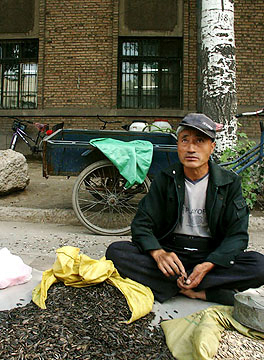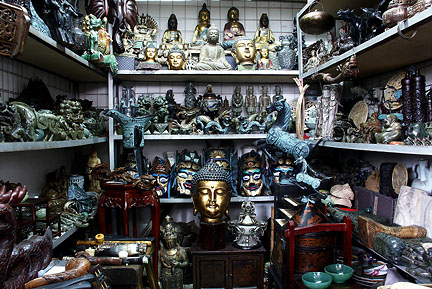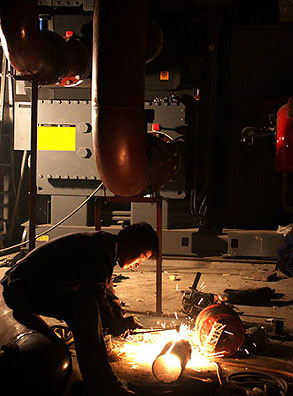Currently my day (EVERY day) is filled with classes, planning lessons, and grading papers. It will take awhile for me to get comfortable with the pace, and to perhaps one day I’ll get ahead so I’m not doing lesson plans at 1:00 AM the night before. But that would require spare time, which is very difficult considering all of the opportunities that seem to open themselves up to me each day.
I have already had about a dozen offers to tutor privately on evenings and weekends. I’ve had to turn most of them down, but for a variety of reasons (mostly because they were great networking opportunities) I decided to accept two. The IT College also had asked if I would teach a class on how to teach English to the other English teachers in the school (twice!); I respectfully declined, truthfully claiming exhaustion.
On Saturday morning I was introduced to a “Holiday School” by a fellow teacher. A “Holiday School” is an English language school that teaches only on weekends and holidays. I thought I was coming there to observe, take pictures of some of the elementary-school kids and maybe make some contacts, but instead I got another offer: “We’re short one English teacher this morning. Can you fill in?”
Well, why not? This school already has full-time Chinese teachers for dispensing English basics; and then they hire native-English-speaking foreigners to rotate through the classes and take over the teacher’s lesson plan for an hour. Both the kids and I had a blast in all 4 classes. I did my (now standard) hat-throwing trick to select students and ask increasingly difficult questions; I got the kids to do role-playing exercises to reinforce the hour’s lesson of food and ordering in restaurants, and I tried to give each one special attention.
By the end of the 4th class the school staff got very positive feedback from the kids (and the Chinese teachers too, apparently), and so they took the unusual steps of feeding me lunch, paying me on the spot and trying to book me for every open weekend between now and January. Currently I need my weekends to decompress and work on this travelogue; but if I chose to work only weekends I could earn a solid 6,000 RMB per month. (In contrast, my current salary is 7,000 RMB for 32 hours/week, which is really 48 hours if you count the time for creating lesson plans, grading papers, and getting lost in taxis shuttling between schools. Hmmm… 85% of the pay for 35% of the work… hmmm… let me think… which do I want? And where’s that contract I supposedly signed a few weeks ago? :-))

Chinese Artwork which adorns my apartment wall.

One of the classrooms at the OM Foreign Language Holiday School.
Opportunity #2 – Recruiters-R-Us
The headhunter who found me a job when I landed in Beijing wants to increase her income stream by having others do recruiting on her behalf. She had heard about the recruiting I had done for [the company I was supposed to work for] in the 2 months before I was supposed to have gone to work for them, and offered a commission for every North American candidate that signed up. The first thing I did was break out my list and contact the 98% of respondents who showed an interest but didn’t go, and sure enough we got one bite the first day. He’s arriving in Beijing tomorrow, and I’ll be getting my first commission check next week.

Tai Chi exercise groups take place in public parks early each morning.
Opportunity #3 – IP-based Cell Sentry
An engineering and business opportunity came to me literally out of the blue, and it happened right in front of the school I teach at! Here I was, exploring the neighborhood around the college one day, not calling attention to myself by looking like a foreigner and taking pictures of something a Chinese citizen sees every day. I was greeted by a man from Singapore and we got to talking. It turns out that we shared a rich background in telecommunications, engineering, and business; and we both looked back fondly on the decommissioning of the old step-by-step telephone switching systems prevalent in the first half of the 20th century. He was sent to China to start a branch office for his telecomm firm just before the telecomm market went bust, and it seems another thing we had in common was we were both looking for the next big business opportunity. He also seemed impressed with my NASA background and business experience.
He invited me to his office where we brainstormed for about an hour. He was in love with his dream of making a cell phone with a camera that could be remotely controlled to take video and send it via a new high-bandwidth cell phone channel, all without a human being there. At first I put on my engineering hat and drew a block diagram of the basic system design, a list of major components, and total effort required; and then I put on my entrepreneur’s hat and listed all the reasons why it wasn’t a desirable venture: Substantial capital would be required, level of miniaturization and integration too difficult for a small firm, consumer electronics are very difficult and expensive to market, and since there was no patent or other protection, if the product were successful we would be obliterated by the big players who could make it smaller, cheaper, and out-market us instantly. Too risky, difficult, no market yet exists, and no clear path to sustained profits.
So then we brainstormed some more applications, and after another hour we came up with something I thought was a great idea which avoided all the pitfalls mentioned above: He knows CEO’s of cell phone companies back in Singapore, one of whom had expressed a frustration to him recently: there is no environmental monitoring of the equipment within cell sites (small disaster-resistant buildings next to every cell phone antenna). Suddenly, the same basic design (with a little more I/O and programming) can now be used for this very niche market with little or no startup cost and no need for patent protection since the target market is too small for others to bother with! We did a back-of-the-envelope calculation on the profit for outfitting each cell location for just one carrier. We would both be able to retire after just one customer. What would I bring to the table? Why, I’d build and program the prototype, perform the system integration, and in general do the kinds of things that I did in my book “Control the World with HP-IL”, which was published 15 years ago when I still thought like an engineer.
Mind you, opportunities like this come my way all of the time, and in the vast majority of cases nothing ever comes of them. (You want proof? I’M IN CHINA!!) However, you never know which ideas are the ones that will pay off, so during the subsequent days that followed I created a document summarizing the opportunity, what we had discussed, the high-level design, business issues, action items, and how the proceeds would be split after expenses. It was well received, and we will resume discussions after he gets back from visiting his family in Singapore.
Opportunity #4 – Xaphoons in China
An opportunity I strongly hoped would come to fruition was the enthusiastic adoption of the Xaphoon in this country. (The Xaphoon is a unique musical instrument and I am its #1 fan. You can learn more about it at www.Xaphoon.com. This is my website; and I sell instruments to independent-thinking musicians this way.)

Construction cranes are ubiquitous in Beijing, and operate around the clock.

A street vendor sells his wares.
The potential is certainly there — unlike in America, every time I play mine in public it draws a crowd of curious onlookers, and every time I walk into a music shop and play one, the employee behind the counter immediately telephones the store owner and enthusiastically tells him (it’s always a ‘him’) about this instrument that they must carry!
But, there’s a problem. At the standard retail price, the plastic Xaphoon is a bargain to American buyers, but hideously expensive to the average Chinese person. (As a reference point, it is 98% of the price of a full-fledged clarinet sold in China.) No amount of listing of benefits (value vs. cost) seems to change peoples’ minds, and no amount of addressing concerns seems to make a difference when approaching store owners and requesting that they carry the Xaphoon. I kid you not, the following conversation actually took place, and at more than one store:
| Objection | Response |
| “The price is too high.” | “Not if you point out how unique this is!
Once you do that, the not-unreasonable price translates into increased profits for you!!” |
| “Nobody has heard of this instrument.” | “Then let’s tell them! Let’s hold a “Free Xaphoon concert and Workshop” day. You publicize it; I’ll go to your stores, play, and teach others to play. If we sell some that day, you get a percentage. No risk to you!” |
| “No other music shops carry this.” | “Don’t you think that would be a competitive advantage for your business?” |
| “The price should be lower because there aren’t that many instruments like it.” | “If the instrument is rare, then it should command a higher price just like anything else.” |
| “Why don’t you sell one to me at no profit just so we can see if there’s a market?” | “Why don’t I sell it to you at full price, and YOU sell it at no profit to see if there’s a market?” |
| “This cardboard box makes it look cheap.” | “Two minutes ago you were complaining about the price being too high. You seem confused!” |
None of this helped; in fact nobody saw the humor or directed irony in some of my responses. Part of the problem is that bargaining here is a hobby for a lot of folks, so I treated it as the friendly game it was. (Although this nearly drove my interpreter nuts!)
If the price could be cut to one fifth the current price, the stores I have visited would gladly order more and would have no problem selling it to their customers. Hard to do, since they are made in America by a very skilled team, plus the additional costs of shipping and customs to China make price reduction impossible unless the drastic step of finding a local (Chinese) manufacturer is taken. There are at least three problems with the ‘local manufacturer’ approach:
- We will be bypassing the skilled team in Indiana who invested so much time, energy, and love into the project (and is also helping to finance it); an unacceptable outcome in my mind.
- There are still tooling costs that have to be made up front — the mold for the Xaphoon cost $90K and almost a year before it was “perfect”; I’m sure at least $10K – $20K will be needed to do the same thing in China.
- If the product is successful, there will be a hundred gazillion unlicensed Chinese copies flooding the market in about 8 minutes. We have lost the race before we even left the starting gate!
- (On the positive side, we could use this opportunity to make a completely different instrument, with a price point so low we could satisfy the local requirements here AND enter the toy market at the same time, a market that is about 1,000 times larger than the music market!)
The puzzled looks I get when I explain why a plastic part is so expensive get even more intense when I explain that there are bamboo versions available as well, but they are much more expensive. “WHAT?? Bamboo in China is as omnipresent as oxygen in the air or office building construction cranes in the sky! Handmade bamboo flutes (all requiring a fraction of the skill that goes into making the Bamboo Xaphoon) all sell for a few dollars! Is the rest of your civilization this backward and illogical?”
At the end of the day I was able to sell all 5 Xaphoons I had brought with me from America to two music shops at a slightly discounted price to allow them to test the waters. After these friendly negotiations were over and we came to an agreement about an introductory and follow-on price, one of the store owners bought us a drink. Good bargaining is obviously a rite of passage leading to true and lasting friendships. The total profit for me was $50; but more importantly I now had 1,000 RMB in my pocket to hold me over until payday. Not bad for half a days’ worth of work.

“Wanna buy some Buddha statues, Mr. Tourist?”

Welding without a face mask?
Cost of Living
Living in China is cheap. How cheap is it? Let me give you some examples:
- $300/month gets you a VERY NICE apartment in a 30-story high-rise in the expensive part of Beijing.
- If you want to buy your own apartment (think of it as a condo), a modest one is $7,000.
- A very good meal at a very fancy restaurant is $10. A good meal anywhere else is about $0.80.
- Health insurance is about $30/year (but that’s probably because the quality sucks).
- Bus is $.10. Subway is $.30. A 15-minute taxi ride is about $2.30.
- Produce doesn’t get any fresher – everything you can imagine is sold at impromptu markets (set up right in front of the promptu ones) and probably picked earlier that day. Bananas are never green.
- If you really like American products, though, they’re much more expensive — half a liter of Listerine (if you can find it) goes for $8, and 4 Gillette Mach 3 razor heads are $8.75. (It’s expensive to be bald in China!). And Xaphoons here are an outrageous $55.00!! 🙂

An open-air market. The variety and freshness of all goods rivals that of American supermarkets – even those fruits you would swear were not in season.
The thought that I could live very nicely here just off the profits from the Xaphoon website, supplemented by weekend work at the holiday school, has not escaped me. (AND it would still leave me free time to pursue anything I wanted!). I find people to be much friendlier here than in America. The food is very good, the police hardly ever arrest you for speaking your mind, and corruption is now officially an executable offense (yeah, that’s a good one..). Now if only the quarantine period for dogs wasn’t 6 months, and if only there was a 100% survival rate for pets being transported in airplane cargo bays at high altitudes for long periods.
Until next time…
“Yours Truly, Gary Friedman”
September 19, 2003